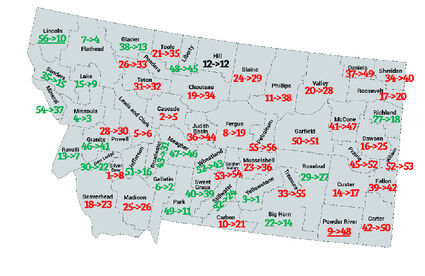Cody McCracken Investigates Montana's License Plate Numbering System
February 1, 2023
Montana is unique in many ways as we all know, wide open spaces under the 'Big Sky'. Beautiful National Parks, State Parks and recreation opportunities are everywhere we look. Montana also has a unique way of doing certain things and one has to be the state license plate number system. To many it's believed that it was originally based on county populations at the time of its creation. Chinook High School Class of 2015 graduate, Cody McCracken took it upon himself to dig a little deeper into its history and found some pretty interesting results.
McCracken Attended MSU - Billings, earning a bachelor's degree in Political Science in 2018. Furthering his education McCracken graduated William & Mary Law School in May, 2022. In July of 2022 he took the District of Columbia Bar to practice law and received word that he had passed in October of 2022. "I started working at a local firm in September of 2022. I'm working on Anti-Trust Law primarily focusing on agricultural markets, so that Montana background comes in handy," said McCracken.
In his spare time, he often looked into Montana history and decided the license plate number system deserved a deeper look, "I made the two maps and put them on twitter thinking people might find it interesting and it blew up from there. I'm a big fan of Montana history and I thought that it would be cool to compare the change from 100 years ago. As far as I am aware of Montana is the only state that used that numbering system for license plate designation. Wyoming used a similar system, but it was based on county land values."

So, what did his investigation uncover, "While I initially believed that our numbers were all based on populations in 1930, I discovered through my research that was not necessarily true. At the time the numbers were given, while 38 did correlate with population, 18 did not." As to why this might be the case, "Theories include influential county members that influenced their number designation. Powder River County was given number 9 but was never anywhere near being the 9th most populated county and Lincoln County at 56 had a much higher population than it represents. That's just one of several theories. Other theories included wrong plates being shipped to the wrong county and officials just deciding to go with it because it was easier than trying to fix it. The number designation was simply an identifier and had no meaning otherwise. They were not used for county funds or anything of that nature."
McCracken enjoys digging deeper into things, "I love History in general and especially Montana History. I think there is an inherent pride in being Montanan with regard to the numbering system. If you are in Billings or Great Falls or even out of state and you see a 24 license plate you instantly connect to it." He is quick to clarify, "In no way am I advocating against the number system. I believe it is unique to Montana and it's just part of our history. That's why I did the research and why I shared it, because it's interesting. I had no idea that so many people would connect with it, and I would be getting requests for interviews afterwards."
There certainly was a bonus to his posting his historic findings, "The best part about doing this study is I have heard from so many people on social media about their individual stories and connections to their own hometown number and it has been really neat to get that kind of feedback," concluded McCracken. "I just posted it to twitter and somehow it made its way to Facebook, and it blew up from there."


